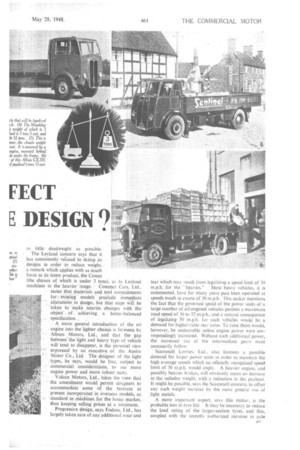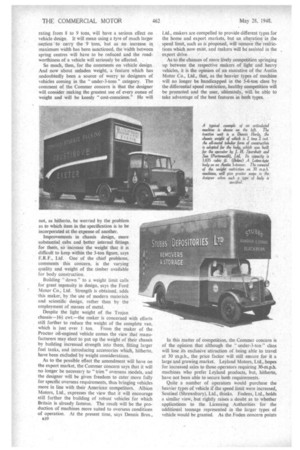IL 30 mph. A FECT VEHI E DESIGN
Page 42

Page 43

Page 44

Page 47

If you've noticed an error in this article please click here to report it so we can fix it.
AS already announced in "The Commercial Motor," the Minister of Transport is giving . favourable consideration to the proposal to raise to 30 m.p.h., the speed limit for pneurnatic-tyred goods vehicles (including articulated outfits) weighing over 3 tons unladen and first registered on or after April 1, 1938, With the exception of a section of the public which fears an increase in road casualties, should the amendment be agreed, and an intransigent, faction among the drivers; this long-overdue concession is generally welcomed.
What effect is it likely to have on vehicle design? Will the makers of the lighter types of vehicle put more metal into their chassis, or the manufacturers of 20-m.p.h. machines find it necessary to carry out revisions in the design of certain chassis components? Again, will 'the present makers of 30-m.p.h. vehicles lose business to .builders of the heavier types of more robust construction?
The answers to thee questions, and general expressions of opinion on a number of aspects of the proposal, have been given by vehicle makers to "The Commercial Motor." Considering; first, the possibility of changes in design, opinions vary widely among makers.
The builders of Commer, JNSN, Trojan, Leyland and Proctor vehicles express the view that chassis design is not likely to be affected to any great extent, The Jensen Co. intends to continue with the policy of reducing the unladen weight of its vehicles, wherever this is practicable, on the ground, that it is in the interests of both producer and user that a vehicle should carry
as little deadweight as possible. The Leyland concern says that it has consistently refused to skimp its designs in order to reduce weight, a remark which applies with as much force to its latest product, the Comet (the chassis of which is under 3 tons), as to Leyland machines in the heavier range. Commer Cars, Ltd., states that materials and tool commitments for existing models preclude immediate alterations in design, but that steps wlit be taken to make interim changes with the object of achieving a better-balanced specification..
A more general introduction of the oil engine into the lighter chassis is foreseen by AlbionMotors, Ltd., and that the gap 'betweenthe light and heavy type of vehicle willtend to disappear, is the personal view expressed by an executive of the Austin Motor Co., Ltd. The .deSigner of the light types, he says, would be free, subject to commercial -.considerations, to use more engine power and More robust units.
Vulcan Motors, Ltd.; takes the view that the amendment would permit designers to accommodate some of the features at present incorporated -in overseas models, as standard in.maehines for the home market, . thus keeping selling prices at a minimum.
Progressive design, says Fodens, Ltd., has largely taken care of any additional wear and tear which may result from legalizing a speed limit of 30
m.p.h., for the "heavies.' Most heavy vehicles, it is commented, have for many years past been operated at ..speeds much in excess of 30 m.p.h. This maker mentions the fact that the governed speed of the power units of a large number of oil-engined vehicles permits a maximum road speed of 30 to 32 m.p.h., and a natural consequence of legalizing 30 m.p.h. for such vehicles would be a demand for higher-ratio rear axles. To raise them would, however, be undesirable unless engine power were correspondingly increased. Without such additional power, the increased use of the intermediate gears must necessarily follow • Scammell Lorries, Ltd., also foresees a possible demand for Iri/ger power units in order to maintain the high average speeds which an officially recognized speed ,limit of 30 m.p.h. would imply. A heavier engine, and possibly heavier brakes, will obviously mean an increase inthe unladen weight, with a reduction in the payload. it might be possible, says the Scammell concern, to offset any such weight increase by the more general use of light. metals.
. iv more important _aspect,: says . this maker, is the probable loss in tyre life It may be necessary to reduce the load ratifyg of the larger-section tyres, and this, coupled with the recently authorized increase in axle
rating from 8 to 9 tons, will have a serious effect on vehicle design. It will mean using a tyre of much larger section to carry the 9 tons, but as no increase in maximum width has been sanctioned, the width between spring centres will have to be reduced and the roadworthiness of a vehicle will seriously be affected.
So much, then, for the comments on vehicle design. And now about unladen weight, a feature which has undoubtedly been a source of worry to designers of vehicles corning in the " under-3-tons " category. The comment of the Commer concern is that the designer will consider making the greatest use of every ounce of weight and will be keenly cost-conscious." He will not, as hitherto, be worried by the problem as to which item in the specification is to be incorporated at the expense of another.
Improvements in chassis design, more substantial cabs and better internal fittings for them, so increase the weight that it is difficult to keep within the 3-ton figure, says E.R.F., Ltd. One of the chief problems, comments this concern, is the varying quality and weight of the timber available for body construction.
Building " down " to a weight limit calls for great ingenuity in design, says the Ford Motor Co., Ltd. Strength is obtained, adds this maker, by the use of modern materials and scientific design, rather than by the employment of masses of metal.
Despite the light weight of the Trojan chassis-16i cwt.—the maker is concerned with efforts still further to reduce the weight of the complete van, which is just over l ton. From the maker of the Proctor oil-engined vehicle comes the view that manufacturers may elect to put up the weight of their chassis by building increased strength into them, fitting larger fuel tanks, and introducing accessories which, hitherto, have been excluded by weight considerations.
As to the possible effect the amendment will have on the export market, the Commer concern says that it will no longer be necessary to " trim " overseas models, and the designer will be given freedom to cater more fully for specific overseas requirements, thus bringing vehicles more in line with their American competitors. Albion Motors, Ltd., expresses the view that it will encourage still further the building of robust vehicles for which Britain is already famous. The result will be the production of machines more suited to overseas conditions of operation. At the present time, says Dennis Bros., RI 0 Ltd., makers are compelled to provide different types for the home and export markets, but an alteration in the speed limit, such as is proposed, will remove the restrictions which now exist, and makers will be assisted in the export drive.
As to the chances of more lively competition springing up between the respective makers of light and heavy vehicles, it is the opinion of an executive of the Austin Motor Co., Ltd., that, as the heavier types of machine will no longer be handicapped in the 5-6-ton class by the differential speed restriction, healthy competition will be promoted and the user, ultimately, will be able to take advantage of the best features in both types.
In this matter of competition, the Commer concern is of the opinion that although the "under-3-ton" class will lose its exclusive attraction of being able to travel at 30 m.p.h., the price factor will still ensure for it a large 4nd growing market. Leyland Motors, Ltd., hopes for increased sales to those operators requiring 30-m.p.h. machines who prefer Leyland products, but, hitherto, have not been able to secure both requirements.
Quite a number of operators would purchase the heavier types of vehicle if the speed limit were increased, Sentinel (Shrewsbury), Ltd., thinks. Fodens, Ltd., holds a similar view, but rightly raises a doubt as to whether applications to the Licensing Authorities for the additional tonnage represented in the larger types of vehicle would be granted. As the Foden concern points
out, this difficulty will undoubtedly limit the sales of heavy vehicles to present operators of the lighter types of machines.
The view expressed by Guy Motors, Ltd., is that the natural line of development will lead in the direction of the articulated vehicle, not, however, to the exclusion of the medium-weight four-wheeler. As the latter has so„much in common with a semi-trailer outfit, vehicle production and maintenance will be assisted. A comment made by the Sentinel concern is that its own products-20 m.p.h. machines—operate more efficiently at higher speed, this remark applying particularly to the power unit. In design, says this concern, it is difficult to match the power of the engine with the transmission details in order to obtain the best results from the engine.
That the amendment will be in the public interest, is the opinion of the maker of Thornycroft vehicles. This view is based on the fact that many operators of the tighter types of vehicle overload' them beyond the maker's maximum-load rating, and in excess of the tyre maker's rating. This manufacturer also foresees a general improvement in the circulation of traffic in built-up areas, because of the smaller percentage of vehicles to which the differential speed limit will apply.
The modern heavy goods vehicle, says MorrisCommercial Cars, Ltd., has developed into a thoroughly efficient machine, with a braking system capable of dealing with maximum loads. Under such conditions, comments this maker, one is at a loss to understand why a heavy goods vehicle is not just as safe at 30 m.p.h. as are the lighter types.
Regarding the danger factor of the amendment. Guy Motors, Ltd., offers a reminder to that section of the public which fears a sudden rise in road casualties. It is to the effect that for many years past double-deck buses have been permitted to travel at 30 m.p.h.. and, what is more, they carry a human load.




















































































